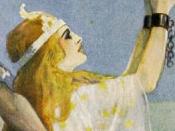"It takes a very open mind indeed to look beyond the unnecessarily gaudy covers, trashy titles and barley acceptable advertisements of the pulps to... recognize the authentic power of a kind of writing that, even at its most mannered and artificial, made most of the fiction of the time taste like a cup of lukewarm consomme at a spinsterish tearoom." -Raymond Chandler
Said to have been proscribed by parents, condoned by educators, and ignored by critics Pulp magazines became the gateway to modern fiction. However, the Pulps had no problems selling and soon became one of the most influential time periods of fiction writing. Many things influenced both the rise of the Pulp generation, and the eventual fall of it, however, the thing that influenced the Pulps the most was the thoughts, views and attitudes of the American people.
Pulp magazines catered to every possible interest and taste of American citizens, and poured from the presses in the Unites States during the years between the two world wars (Haining).
The illiteracy rate in the United States at the turn of the century decreased from 13.3 percent in 1886 to 10.7 percent in 1900, an improvement of nearly 20 percent in 14 years. The growth and education of the middle and lower classes led to a need for affordable and entertaining literature (Goodstone). Most of the magazines that were being published during this time were called Slicks, which were large circulation consumer magazines, and at around fifty cents per issue, they catered to the better-off sections of society. Slicks were printed on coated stock paper, and contained articles chosen for popular appeal and fiction limited to formalized Brown 2
stories with happy endings (Babcock Grove). Pulp magazines came to be commercial rivals to the slicks, and quickly earned a reputation for...

![Bikeway [Haining Road / Shanghai]](https://s.writework.com/uploads/5/50405/bikeway-haining-road-shanghai-thumb.jpg)
